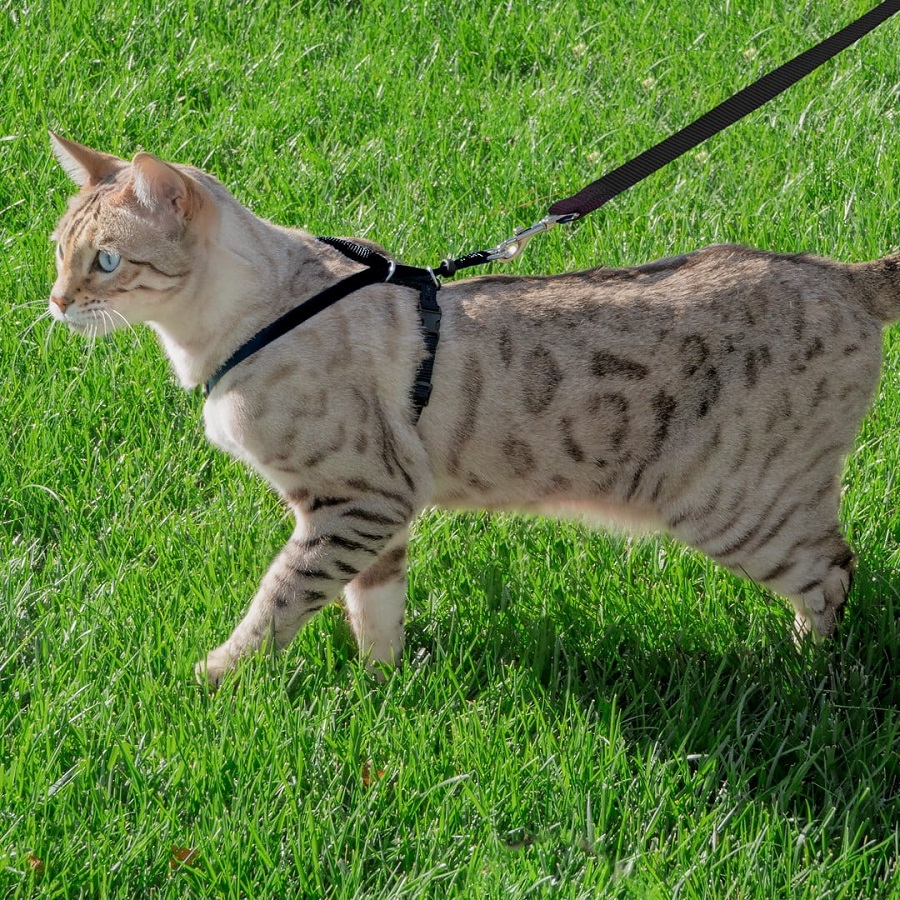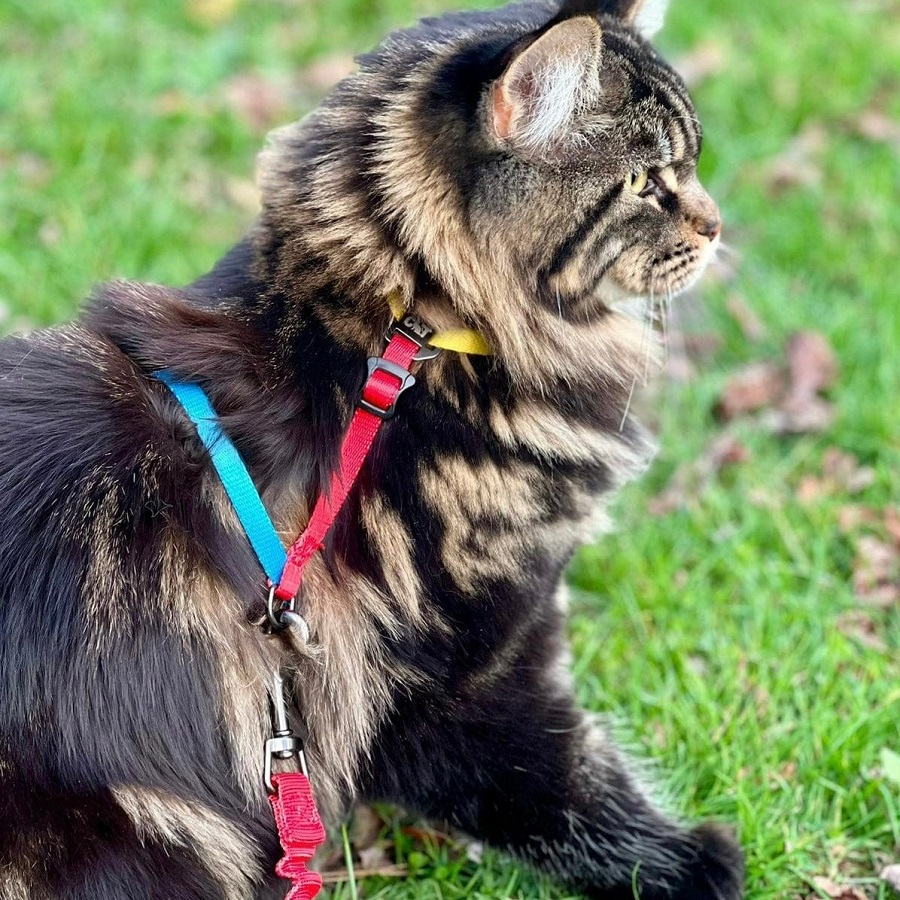Introduction to Cat Leash Walking
Cat leash walking is steadily gaining popularity among pet owners. While traditionally seen as independent creatures happy to roam on their own, some cats may enjoy the structured adventure that a leash provides. Leash walking can offer controlled outdoor experiences, growing as a way to exercise and stimulate your feline friend both mentally and physically. However, introducing a cat to a harness and leash should be a gradual and positive experience for both you and your pet.
Many wonder, do cats like leashes? The answer varies with each individual cat. Some cats may take to a leash with curiosity and excitement, while others might show resistance or fear. It is essential to respect your cat’s comfort levels and personal preferences when considering leash walking. Starting the process indoors is recommended, allowing your cat to get used to the harness in a familiar environment.
As an indoor activity, cats are used to their territory and routines. Transitioning to outdoor activities requires guidance and patience from the owner. It is critical to ensure that the outdoor experience is safe, enjoyable, and stress-free. Keeping these points in mind, we’ll delve into the pros and cons of cat leash walking, discussing how to prepare your cat for this activity, and sharing necessary safety tips for those outdoor adventures.

Evaluating the Pros of Leash Walking
Leash walking a cat can bring many advantages. Here, we’ll explore the benefits it holds for both you and your feline companion.
Physical Exercise and Health
Leash walking serves as a great source of exercise for cats. It can prevent obesity, a common issue in indoor cats. Through regular walks, cats get to stretch their legs, strengthen their muscles, and maintain a healthy weight. The outdoors also offers fresh air and sunlight, contributing to your cat’s overall wellbeing.
Mental Stimulation and Behavior
Cats are naturally curious. A good walk can provide mental stimulation as they encounter new sights, smells, and sounds. This varied environment can help reduce common behavioral problems. It may prevent destructive habits that stem from boredom or excess energy.
Safety and Supervised Exploration
When you walk your cat on a leash, it allows for safe exploration. This is safer than letting them roam free where they might face dangers like traffic or predators. Your presence ensures they can satisfy their curiosity without the associated risks.
Enhanced Bonding Experience
Walking together strengthens the bond between cat and owner. This shared activity builds trust and companionship. You become a source of security in new environments, which can deepen the connection with your pet.
Controlled Outdoor Access
Leash walking provides controlled access to the outdoors, particularly important for cats in urban areas. They can enjoy the benefits of outdoor life under your watchful eye. This also prevents the negative environmental impacts of free-roaming.
Overall, leash walking can enrich your cat’s life in many ways. It facilitates physical health, mental sharpness, and emotional bonds. It is a positive step towards a happy and balanced feline lifestyle.
Understanding the Cons of Leash Walking
Leash walking isn’t all positives. Like any activity, it comes with potential downsides. Here are cons to consider before strapping on that harness.
Possibility of Stress and Anxiety
Just as humans get stressed, cats can too, especially when exposed to new situations. Leash walking can make some cats anxious. If they show signs of discomfort or fear, it could be distressing for them.
Risk of Escaping
Even the best harnesses are not foolproof. A scared or determined cat might slip out. This could lead to your cat getting lost or injured, a risk not to take lightly.
Exposure to Dangers
Outside, cats may face threats they’re not used to indoors. Dogs, wildlife, and even cars pose real risks when out on a walk, even if you’re there.
Disease and Parasites
The outdoors harbor fleas, ticks, and other parasites. Walking your cat might expose them to these pests, and in turn, cause health issues.
Challenging to Train
Not all cats take to leash walking with ease. Training can be long and require lots of patience. Some cats may never accept a harness or leash willingly.
Potential Behavior Changes
Some cats become fixated on going outside after experiencing leash walks. They may door-dash or howl to go out, which can be tough to manage.
To sum up, while leash walking has benefits, it’s not for every cat. Look out for your cat’s cues and always prioritize their safety and well-being.

Preparing Your Cat for a Walk with a Harness
Before stepping outside, prep your cat for harness walking. Start slow and be patient. Here are steps to follow:
Choose the Right Harness
Pick a snug, comfy harness that your cat can’t slip out of. Ensure it’s the correct size.
Introduce the Harness Slowly
Let your cat sniff and explore the harness at home. Place it near their bedding or feeding area.
Use Positive Reinforcement
Offer treats and praise when your cat interacts with the harness positively. Make it a fun experience.
Practice Indoors
Allow your cat to wear the harness indoors. Start with short sessions. Gradually increase the duration.
Attach the Leash
Once comfy with the harness, attach the leash. Let your cat lead you inside. Keep it loose.
Supervise and Interact
Stay with your cat during indoor leash time. Play and interact to associate it with good times.
Ensure Identification
Your cat should have ID tags and be microchipped. In case they escape, they can be returned safely.
Practice Patience
Some cats take time to accept a harness. Never rush or force the process. Let your cat set the pace.
Acknowledge Progress
Celebrate small wins. If your cat wears the harness without fuss, that’s progress. Keep encouraging.
Patience is key when preparing your cat for a walk. Follow these steps and let your cat’s comfort guide the training. Read your cat’s reactions to make sure they like leashes and walks.

Safety Tips for Outdoor Adventures
Taking your cat on outdoor adventures can be thrilling, but safety comes first. Here are essential tips to ensure a safe and enjoyable experience for your furry friend.
Choose a Secure Harness and Leash
Select a well-fitting harness that your cat cannot escape from. The leash should be sturdy and comfortable to hold.
Start with Short Sessions
Begin with brief outdoor visits to avoid overwhelming your cat. Gradually increase the duration as they get comfortable.
Be Mindful of the Environment
Avoid busy streets and loud noises that could scare your cat. Opt for quiet, secure areas instead.
Keep a Close Eye on Your Cat
Always watch your cat closely during walks. Be aware of their behavior and surroundings.
Update Vaccinations and Parasite Control
Make sure your cat’s vaccinations are current, and they’re protected against fleas and ticks.
Carry a Cat Carrier
Bring a cat carrier for a quick retreat if your cat becomes stressed or there are dangers.
Avoid Peak Sun Hours
Walk your cat during cooler times to prevent overheating, like early morning or late afternoon.
Offer Water and Shade
Provide access to fresh water and shady spots to rest during your adventures.
Know Your Cat’s Limits
Recognize when your cat has had enough and is ready to go home. Never push them beyond their comfort zone.
By following these safety tips, you and your cat can enjoy the great outdoors safely and happily.
The Debate: Indoor Cat vs. Outdoor Cat Experiences
Choosing between keeping a cat indoors or allowing outdoor access is a hot topic. Indoor cats stay safe but may miss out on natural behaviors. Outdoor cats enjoy freedom but face risks like traffic and predators. The middle ground? Leash walking, which ensures safety while exploring outdoors. But not all pets or owners may find it suitable.
Indoor settings provide control over a cat’s environment. They’re safe from external threats and disease. Yet, they might lack stimulation. Outdoor exposure offers cats a chance to engage fully in their instincts. They can hunt, climb, and explore, which is great for their mood and health. However, dangers lurk outside that could harm them or shorten their lives.
Leash walking emerges as a compromise. It can offer the best of both worlds, with supervision. It combines the security of indoors and the thrill of the outdoors. But, it needs proper training and equipment to be enjoyable and safe.
In conclusion, deciding between indoor and outdoor experiences depends on many factors. These include your cat’s personality, your living environment, and your ability to supervise. Leash walking isn’t a universal solution, but it’s an option to consider. Each cat is different, and so are their needs for exploration and safety.
Bonding Benefits: Exploring Together
Bonding with your cat gets stronger with leash walks. As you and your cat explore together, the trust between you grows. This experience allows your cat to see you as a protector in new situations. It also creates a special bond that only shared adventures can bring.
Building Trust
Walking your cat helps build a deep trust. In a new environment, your cat will look to you for safety. As you offer comfort and protection, your cat learns to rely on you more.
Leash walks are shared activities that both of you can enjoy. These experiences create fond memories and strengthen your relationship. They give you and your cat a unique way to interact.
Training as a Bonding Activity
Training your cat to walk on a leash can be a bonding activity. Use positive reinforcement to encourage your cat. Every step your cat takes in learning is an opportunity to grow closer.
Improve Your Cat’s Mood
Walking boosts your cat’s mood and yours. It’s a chance to relieve stress and promote happiness in your daily routine. A happy cat is more likely to form a closer relationship with its owner.
Explore Safely
Leash walks let your cat explore without the risks of roaming free. It’s a controlled way to satisfy their curiosity and have some fun together safely.
Addressing Common Concerns and Questions
When considering walking your cat using a leash, many owners have concerns and queries. Here, we address the common ones to provide clarity.
How to Tell if Your Cat Likes the Leash
Look for signs of comfort and curiosity when introducing the leash to your cat. If they resist or seem scared, it may not be for them. Cats who like leashes will show interest and even excitement. Watch your cat’s body language closely.
Can All Cats Adapt to Leash Walking
Not all cats will adapt to leash walking. It depends on their personality and past experiences. Some may love it; others might never feel comfortable. It’s crucial to follow your individual cat’s lead.
What Age to Start Leash Training
Ideally, start leash training when your cat is a kitten. Kittens are more adaptable to new experiences. However, with patience, adult cats can also learn to walk on a leash.
Is It Safe to Walk Cats in Urban Areas
Walking cats in urban areas can be safe with a secure harness and a cautious approach. Stick to quiet areas, avoid traffic, and keep a tight hold on the leash.
Can Leash Walking Replace Playtime
Leash walking should complement playtime, not replace it. Indoor activities still play a vital role in your cat’s life and help meet their need for exercise and mental stimulation.
Dealing with the Fear of Escaping
Choose a well-fitting, escape-proof harness to minimize the risk of your cat slipping out. Practice indoors first and gradually build up to outdoor adventures.
Addressing Outdoor Hazards
Be vigilant of hazards such as traffic, other animals, and toxic plants. Keep your walks in safe, controlled environments to protect your cat.
By addressing these concerns, you can make informed decisions about leash walking your cat and make the experience enjoyable and beneficial for both of you.










